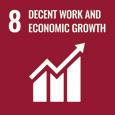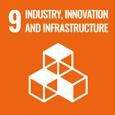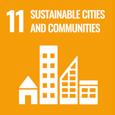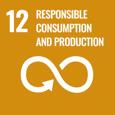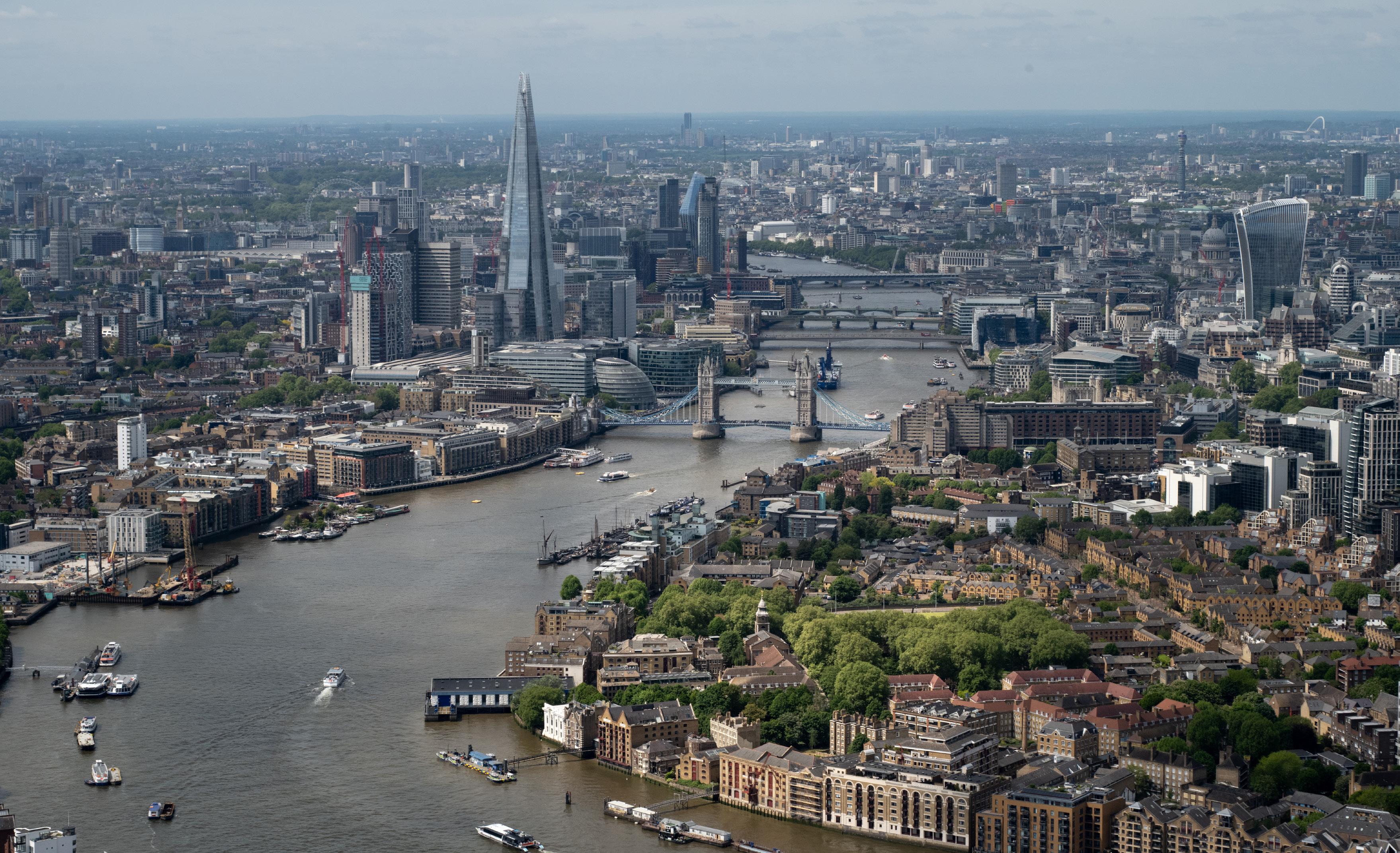RECONNECTING LONDON WITH THE RIVER THAMES
TURNING A VISION INTO A LASTING LEGACY
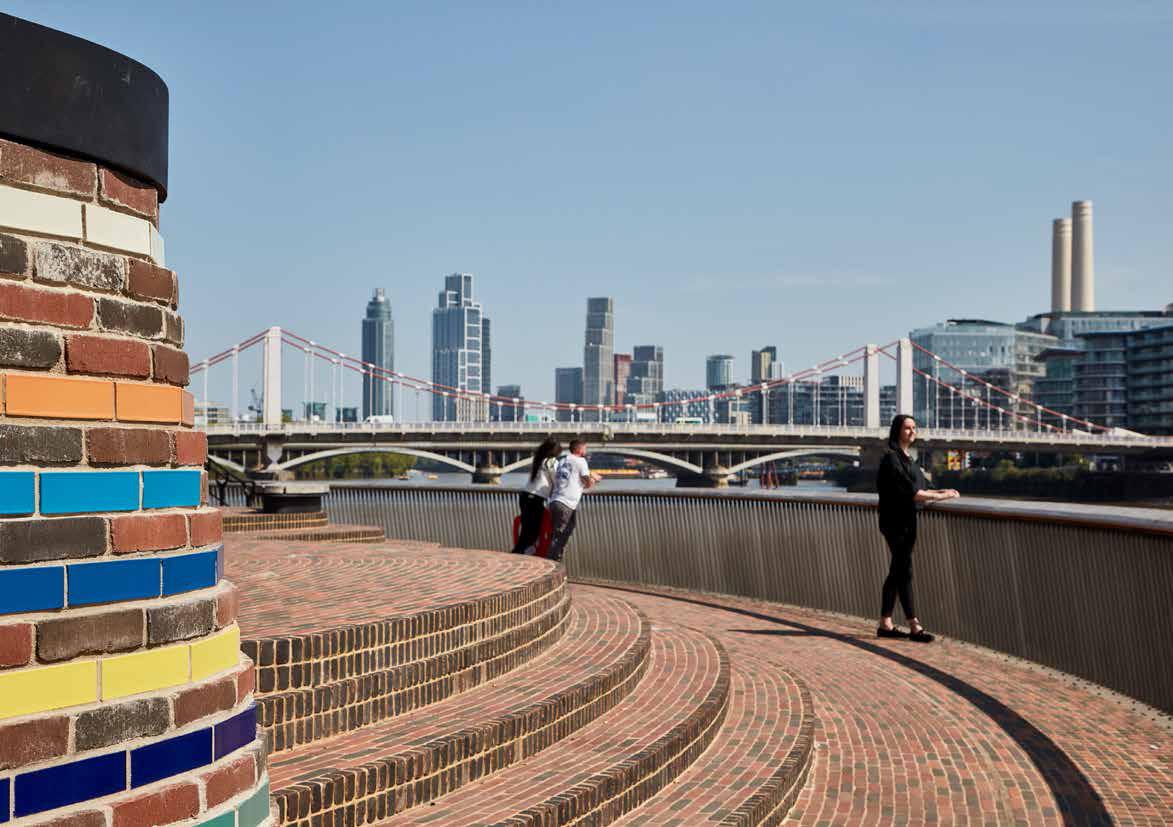
September 2025


RECONNECTING LONDON WITH THE RIVER THAMES
TURNING A VISION INTO A LASTING LEGACY

September 2025

In Tideway’s legacy statement at the start of the project, our then Chair Sir Neville Simms said: “More than 150 years ago, Sir Joseph Bazalgette had the vision and determination to see through an ambitious plan to establish the sewerage network that has served London so well. Bazalgette’s primary aim was to protect public health. The legacy he left is much broader. It’s time to pick up the baton from Bazalgette.”
In that statement we laid out our own wider vision for the Tideway project. We understood that although our primary task was to protect the tidal River Thames from sewage pollution, there was an opportunity to do much more. We wanted to maximise the broader benefits that the project could offer - we called this ‘reconnecting London with the River Thames’.
Some 10 years later, we believe we have achieved a wider legacy for the river and the people who live by it, work on it, or use it for recreation. This report outlines how we have delivered that reconnection vision, as well as outlining our performance against all 54 legacy commitments which we set out when we began construction.
The project’s core environmental benefits have started to be delivered – we have already intercepted several million cubic metres of sewage that would otherwise have spilled into the river.
The project’s wider benefits have also been a vital part of the success of our project. We did not see it as a ‘nice to have’, it was always core to what we were here to do and was embedded in our financing, governance and contracts, making it a whole team effort. I want to thank all those project workers who have created this wider legacy – you have picked up and run with the baton and helped deliver benefits to so many people, both now and into the future.
Looking forward, Tideway will continue not only to be responsible for the tunnel but to play a role in opportunities opened up by what we’ve delivered, to build on our ‘reconnection’ legacy. This report outlines what has been achieved to set it up, and hope you enjoy reading it.


In the early phases, the project spoke to local communities, local and national government, London business groups and river organisations as we explored what benefits could be delivered. This engagement highlighted the opportunity for a ‘big picture’ social benefit to redefine Londoners’ relationship with the river: ‘Reconnecting London with the River Thames’.
As the project began, we set out our legacy objectives under five themes that captured the range of opportunities – Environment; Health, Safety and Wellbeing; Economy; People; and Place. For each objective, specific commitments were made to demonstrate how the project would deliver them. The ‘reconnection’ aim was reflected across almost all areas.
Legacy was also integrated into the project’s financing and contracts.
Tideway has become an established issuer of Green Bonds (for projects that deliver positive environmental outcomes) and our Sustainable Finance
Framework was linked to the wider legacy programme so that some of the cost of debt reduces if 85% of our commitments are on track against target.
In 2025 we became the first UK corporate to issue Blue Bonds – in recognition of the benefit of Tideway to rivers and seas and showing our continued commitment even in the end stages of the project to innovative and sustainable financing.
We also embedded legacy delivery into our contracts with Main Works Contractors (MWCs), setting detailed targets in line with overall aims and including a requirement for quarterly reporting, with penalties if reports were not delivered. The MWCs were required to employ specialist legacy staff to oversee delivery of their obligations.
In 2018 we became the first UK infrastructure project to map our legacy commitments to the United Nations Sustainable Development Goals (UN SDGs) so that we could demonstrate our wider impact on society and the environment. You can see a short summary of how we delivered a contribution to the mapped UN SDGs on page 19.
We also knew that every pound spent should create best value - to the project, the economy, the environment, and the people of London. The original cost-benefit assessment of the environmental benefits of a cleaner river showed a benefit range of £7.4 billion to £12.7 billion for a ‘whole life’ cost of around £4.1 billion. We supplemented this in 2023 with an analysis of the wider social value of our legacy programme, which showed a benefit of £1.72 for every £1 spent. This was based on HM Treasury Green Book guidance and counted only those benefits that were truly additional and beyond minimum consenting requirements.
As the legacy programme has progressed, we have closed out commitments as activities have completed. We have currently closed out 46 of the 54 commitments, achieving or exceeding the target in 42 of them – you can see a full rundown in the performance table on pages 16 to 19. The remaining commitments break down as follows: three relate to remaining public realm openings; one relates to our health, safety and wellbeing commitment to have no major injuries, which will remain open until the final element of above-ground construction is finished; and four relate to the core environmental impact of the tunnel. For more on our environmental impact, see the next section.
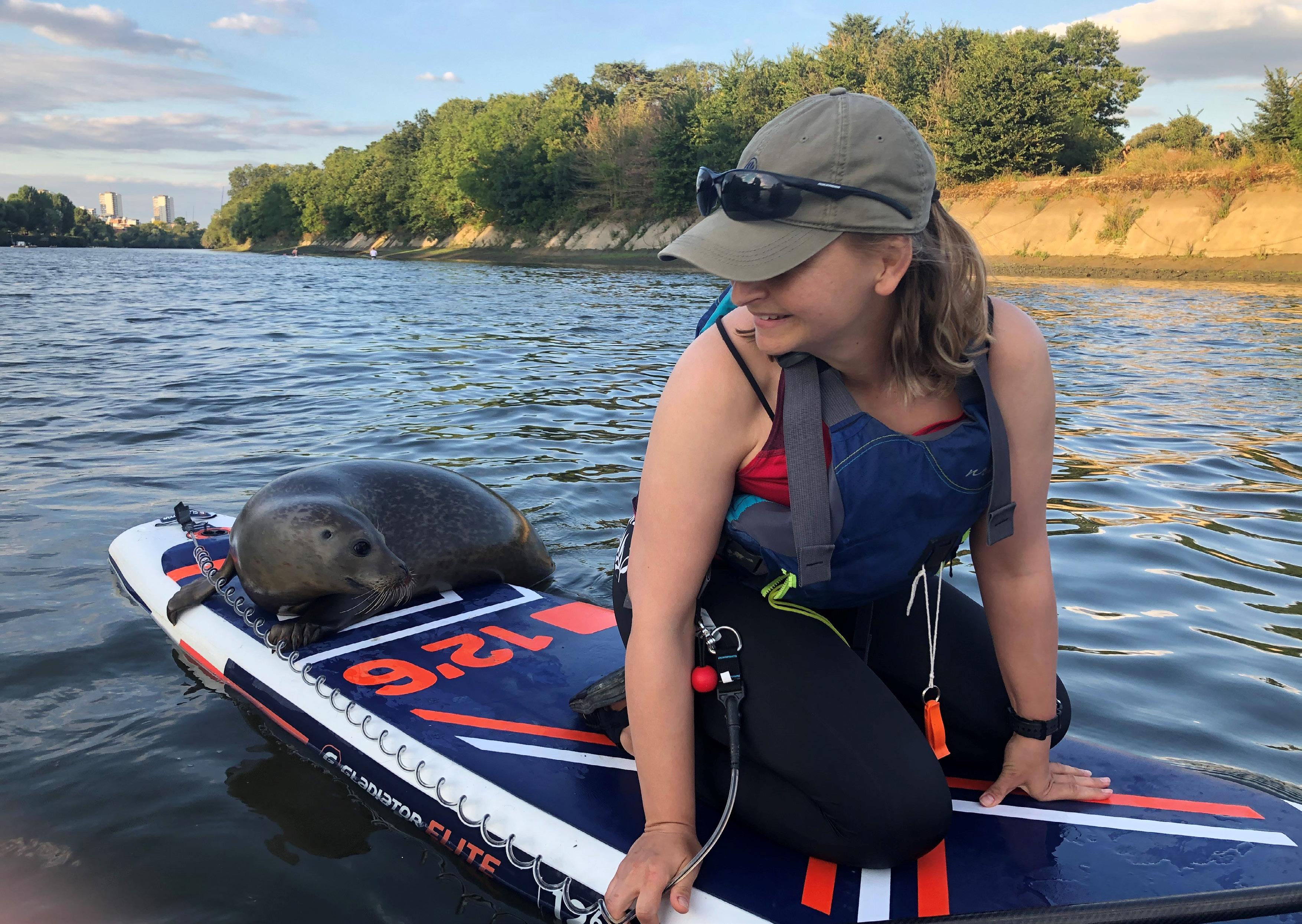
The River Thames is the UK’s second largest river. It supports 115 different fish species, a seal population of around 4,000 and 92 bird species. It also has a thriving recreational and sporting scene, from the world-famous University Boat Race to the estimated 5,800 people who take part in rowing on the Thames every year1. A healthier river will provide a healthier environment for all of its inhabitants and those who enjoy spending time on it and near it.
On 14 February 2025, Tideway announced that the Thames Tideway Tunnel was fully connected. This marked a major step forward – after almost nine years of construction, the new infrastructure had been connected to the original Bazalgette sewers, and now only in the most extreme weather conditions, would they discharge to the river causing environmental damage.
9.3 million
CUBIC
Cleaning up the Thames – by reducing sewage discharges – is the core benefit of the Tideway project, and it is already doing its job. At the time of writing 9.3 million cubic metres of sewage discharges had been prevented from entering the river, of an estimated annual volume of around 39 million cubic metres in a typical year. A tracker on Tideway’s homepage is updated with the latest figures on sewage pollution prevented.
In a typical year, the tunnel, along with Thames Water-operated Lee Tunnel is expected to prevent around 95 per cent of sewage discharges from entering the river. This will benefit aquatic life, particularly the juvenile fish population which is sensitive to sewage discharge pollution. It will also support river biodiversity more broadly and benefit people who use the river for recreation and sport, such as rowers and paddleboarders, who will be at a lower risk of coming into contact with harmful bacteria.
The Lee Tunnel, in many ways a trailblazer for the Thames Tideway Tunnel, has been operating since 2016, and has already delivered demonstrable environmental benefits. The Lee Tunnel, which now connects with the TTT to form the London Tideway Tunnel network, protects the Channelsea River from sewage pollution by intercepting the Abbey Mills CSO. A fish survey of 2023 was encouraging, finding 14 different species in the river, and an improvement in overall water quality.
Tideway is working with environmental charity Thames21 and the UK Centre for Ecology and Hydrology to assess the impact of the tunnel on water quality on the tidal Thames and will be publishing findings of this new monitoring project to help promote greater understanding of the Thames environment.
Earlier in the project, Tideway funded a research project by ZSL to assess the juvenile fish population of the Thames, to provide a baseline before the tunnel came into operation. ZSL’s State of the Thames research project will also provide invaluable insights into the impact of the Tideway project on the biodiversity of the river.
Thames Water will also be evidencing the tunnel’s environmental impact legacy in a Benefits Realisation Report. The first report is expected to be published in 2026.
Beyond the core benefit of water quality, Tideway aimed to deliver additional environmental benefits wherever possible at the same time as limiting impacts during construction.
The project achieved a 28 per cent reduction in its carbon footprint compared to original estimates through design optimisation, use of lower carbon materials, reducing the use of heavy road vehicles and engagement with the supply-chain to incentivise innovation. You can read more in our Carbon Case Study.
To support biodiversity and climate resilience, we installed almost 900m2 of biodiverse roofs on our above-ground permanent structures. We exceeded our target of planting two trees for every one removed and our riverside spaces include 1,000m2 of intertidal terracing (see next section).
Sir Joseph Bazalgette’s visionary overhaul of London’s sewerage system not only transformed public health but also changed the look and character of the city with the creation of the Chelsea, Victoria and Albert Embankments.
More than 150 years later, Tideway has followed his example.
As well as delivering a 25km sewage tunnel to massively reduce sewage pollution into the tidal river, the project has also created seven riverside community spaces among more than three acres of new public realm – our above-ground legacy for London.
These new riverside spaces – at Putney, Chelsea, Vauxhall, Battersea, Victoria, Blackfriars and Wapping – provide a new contribution to the vibrancy of the city and connect the capital’s residents and visitors with London’s largest open space – the River Thames.
Each of them has a name which references either the local area, a nearby ‘lost river’ or in the case of Blackfriars – the largest of the seven –Sir Joseph himself.
Our new community spaces have been enhanced with public artworks, following a diverse and ambitious art programme. The artworks, which range from standalone sculptures to pieces integrated into the facades of structures, seating or balustrades, are all inspired by the heritage of the local area.
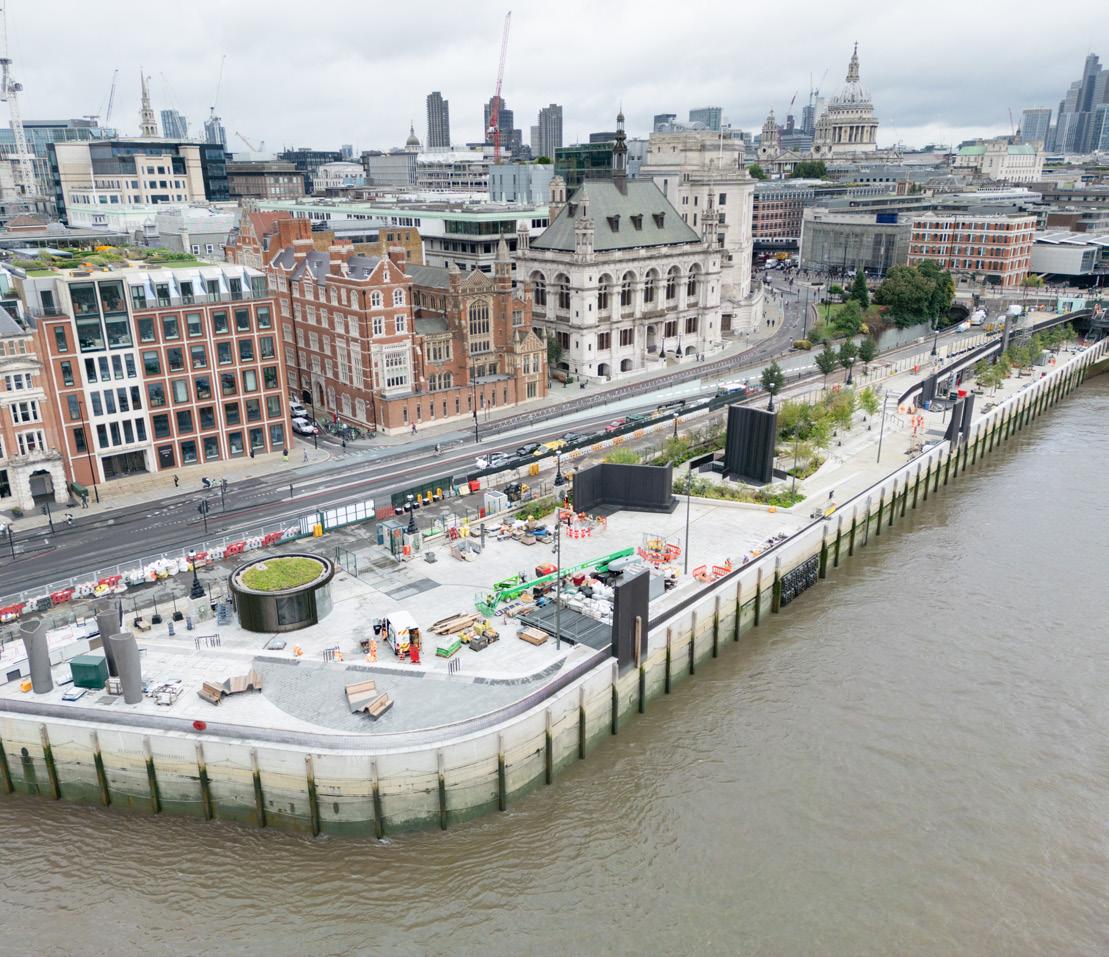

Some of the spaces realise the ‘river reconnection’ ambition in a very literal way. Parts of the new spaces at Victoria and King Edward Memorial Park are ‘floodable’ at high tides, giving Londoners the first opportunity of its kind to dip their toe in a cleaner River Thames.
The new spaces do more than offering new river views and experiences – they support the river’s biodiversity, too.
Only around two per cent of the edges of the Thames are natural. Several of the new spaces have intertidal terraces, planted with species indigenous to the river, to encourage insects, birds and fish to use them for food and shelter – a total of over 1,000 m2. In addition, the river walls at King Edward Memorial Park and Chambers Wharf have been designed with deeply recessed niches and a rough texture to encourage colonisation by flora and microorganisms.
Each new space is designed to be inclusive – where possible, the permanent spaces were given step-free access, seating areas for wheelchair users to be alongside seated companions and tactile paving. New signage provides wayfinding and information about the spaces and engineering beneath.
We have also enhanced the Thames Path at eight different locations through widening, better lighting and surfacing or making new connections.
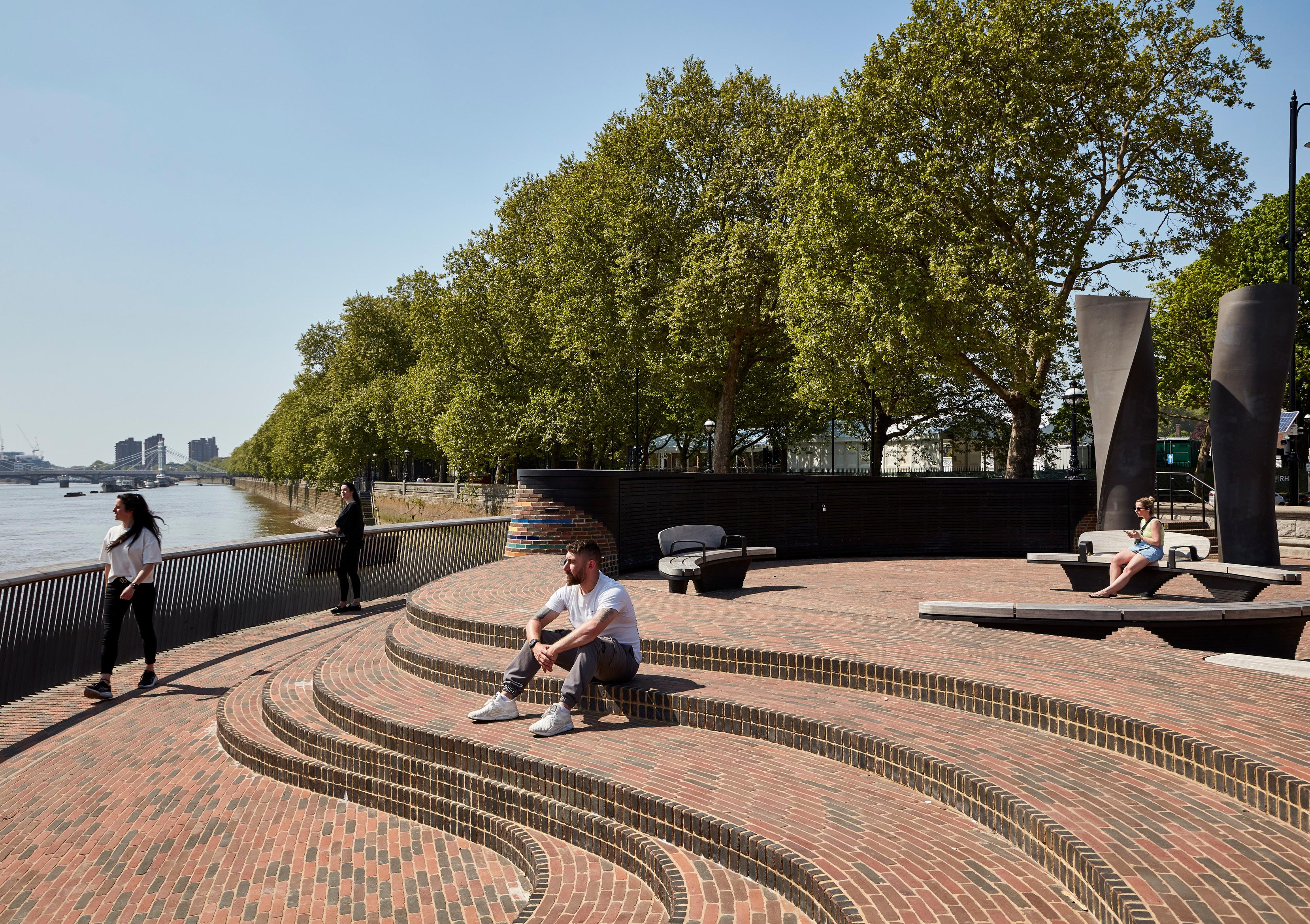
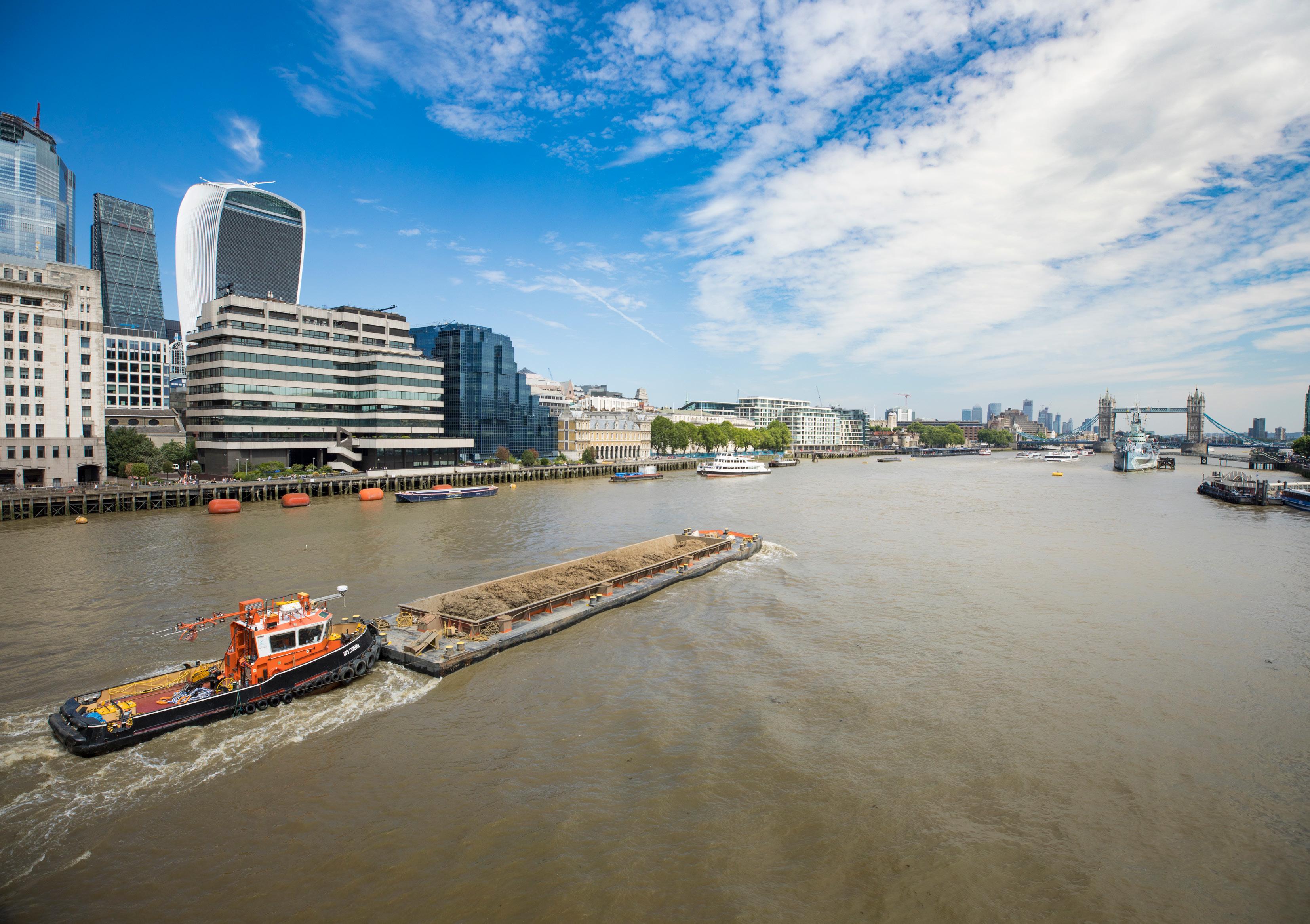
Better health and safety standards and training for River Thames operators and those working beside the river.
A new training organisation for the Thames and, for the first time, continuous professional development courses for river workers.
New skilled maritime jobs for local people and a new apprenticeship scheme as part of a rejuvenated river economy.
More than 700,000 lorry journeys avoided, saving 24,600 tonnes of carbon emissions as well as reducing congestion and the risk to vulnerable road users.
These are some of the wider legacies that resulted from Tideway seizing the opportunity to maximise use of the river during the project.
We committed to an unprecedented level of river transport - our marine activities more than doubled major freight movements on the Thames from around 12 a day in 2012 to around 30 a day at the peak of construction in 2019. We committed to use river transport beyond not only what we were consented to do, but also beyond what was originally agreed in our Main Works Contracts – literally ‘more by river’.
We knew this approach would take hundreds of thousands of lorries off London’s roads - which is better for congestion, for road safety and for the environment. But we also knew the general level of training of new workers on the river was inconsistent and the standard of competence across the sector was variable - in 2012 there was an 85 per cent failure rate in those taking Boatmaster exams with the Maritime and Coastguard Agency.
So our programme focused on clarifying, raising and policing standards and investing in training. We created a Code of Marine Practice, which included the International Safety Management (ISM) standard that had already been adopted by Thames high-speed passenger operators but wasn’t mandated for freight.
In training, we became a founding partner of a new training organisation, the Thames Skills Academy (TSA) and this has been the cornerstone of our river skills legacy.
The TSA developed the country’s first bespoke safety training programme for non-maritime staff working near rivers for Tideway staff. It is now the new norm for all major construction projects on and alongside the River Thames. We supported 75 new apprenticeships through the TSA. Now in its fifth year, the apprenticeship is now the biggest trainer of Boatmasters in the UK – and the pass rate of apprentices taking the Boatmaster exams is 94 per cent. The TSA also developed the only port-wide continuous professional development (CPD) programme in the UK. Seventy per cent of Thames operators are now TSA members.
As well as the environmental benefits of using the river rather than roads, our barges have helped to deliver a bigger legacy in the form of new wetlands in the Thames estuary at Rainham, created using spoil from the project. The wetlands are already attracting a wide range of species including lapwing, little ringed plover and red shank. Alan Johnson, the RSPB’s Area Manager for Kent and Essex, said: “We fully expect the wildlife here to flourish. Tideway’s commitment to beneficially reuse their excavated material is great to see.”

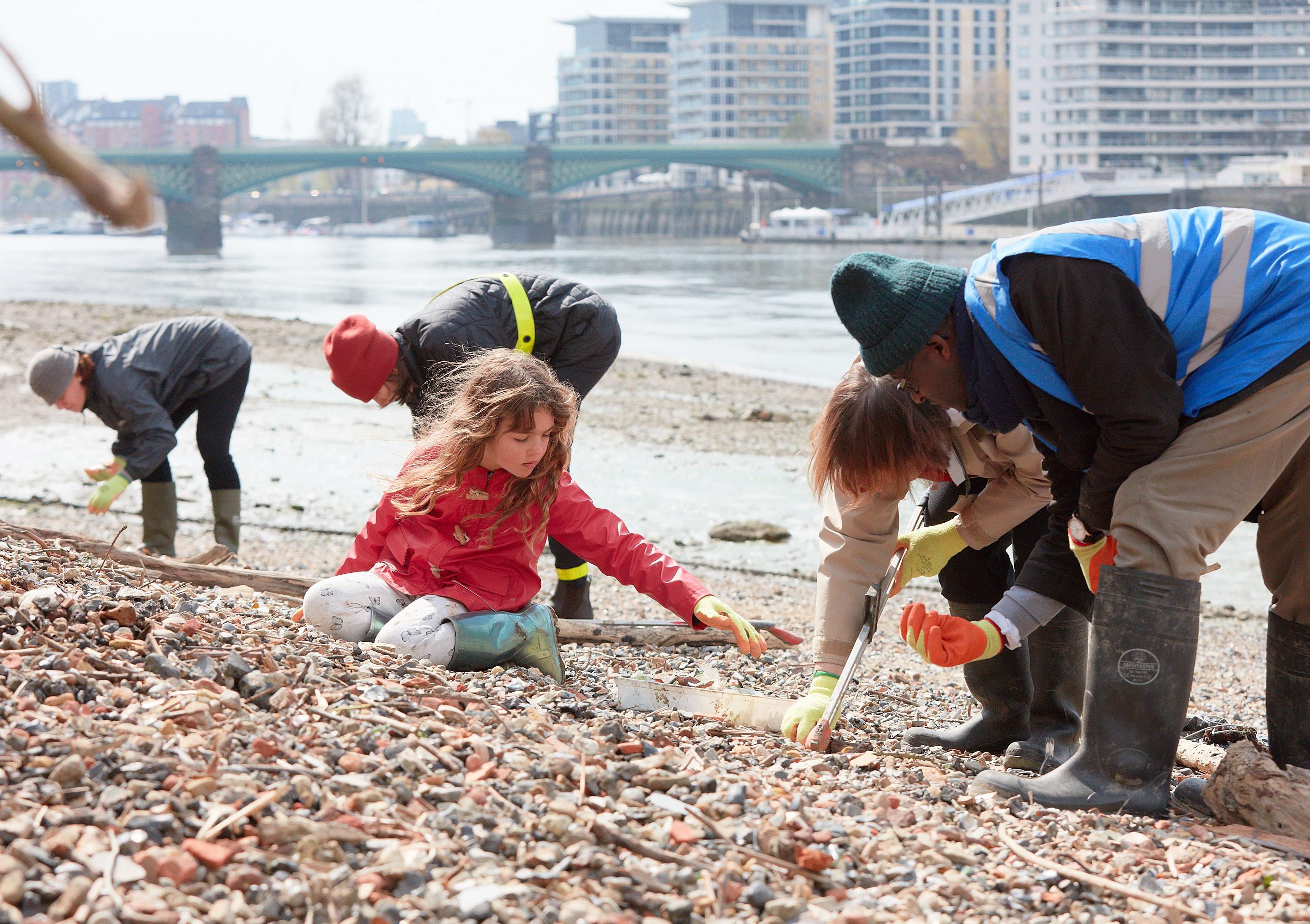
“A river is more than an amenity. It is a treasure.”
This quote by 19th Century American poet Oliver Wendell Holmes captures an essential love of rivers which lies behind the guiding principles of Tideway’s legacy programme. This is particularly true of our community ‘river reconnection’ programmes, where shared values and goals around protecting and utilising the River Thames have led to partnerships which have engaged thousands of people and delivered wider benefits to all parties.
These partnerships were based on themes around river environment, leisure and heritage – you can read more about all of them here but here are two leading examples:

Tideway supported this community programme, run by environmental charity Thames21, for 10 years. Thames River Watch (TRW) encourages riverside communities to come to foreshores across the tidal Thames to both understand and protect the health of the river.
Over those 10 years, the programme not only engaged thousands of people but also supported the charity’s successful influencing for change. TRW data showing that more than 100,000 single use plastic bottles were collected by volunteers from the Thames foreshore was used as part of successful campaigning efforts to convince the Mayor of London Sir Sadiq Khan to introduce more water fountains and data on the vast number of wet wipes collected from the foreshore at Hammersmith was used by MP Fleur Anderson as she put forward legislation banning plastic in wet wipes.
These successes supported Thames21’s own development from a charity that mainly focused on community engagement to one which also successfully campaigns for real change.
In recent years TRW has also focused on giving riverside communities a greater sense of belonging to their area, often reducing their isolation and always opening their eyes to the environmental threats faced by rivers. Other funders have now replaced Tideway, and the programme continues to collect data and increase the diversity of Thames21’s volunteer base.


Active Row, run by sports charity London Youth Rowing (LYR), engaged more than 7,000 young Londoners in on-water and indoor rowing between 2017 and 2021. Co-funded by Tideway and Sport England, it had a wellbeing impact of £40 for every £1 invested, with benefits about three times higher for those on free school meals and about twice as big for those who have a disability. A total of 42 per cent of the young people participating were girls; 68 per cent were from minority ethnic backgrounds and 29 per cent were eligible for free school meals. You can read LYR’s impact report here.
Tideway also supported LYR for 10 years. We have supported new physical infrastructure at their Olympic Park base, helped them with a social enterprise to generate additional income and developed new fundraising opportunities, including launching the Oarsome Challenge, a 16-mile row on the Thames through central London, which is now an annual LYR fundraiser.
CEO Matt Rostron said: “Tideway have helped us to mature as an organisation and their support will continue to determine how we will operate and develop in the future. That’s a real legacy.”
“I am born and raised in Fulham. One of my heroes is my nan … one of the reasons joined the project as an apprentice engineer was my nan lived a stone’s throw from the Carnwath Road site. A lot of my drive, my commitment, my effort has been to make my nan proud, as well as the rest of my family.”

Ray Cantwell, from our West and Central Delivery Teams, spoke about his pride in working for the project when he took part in our ‘People Behind The Tunnel’ series of films. He is one example of how Tideway aimed to leave a jobs and skills legacy for local communities through our employment programmes.
We achieved our target for a quarter of our workers to be from one of the 14 boroughs along the tunnel route, and we exceeded our target for one in 50 to be an apprentice – 151 individuals had a sustained apprenticeship with the project, a ratio of one in 29. We set a target for 30 per cent of our river workers to be from Greater London, Kent or Essex and achieved 68 per cent.
We also wanted to leave a legacy for those who find it harder to get or keep a job.
We employed 37 people who had a previous conviction - research has found that many former offenders find it almost impossible to get a job. We did not achieve our target of one in 100 of the workforce, achieving 1 in 144, but our programme delivered a social value of £2.3 million.
More than 1,000 people previously out of work got a job with us, creating a social value of £4.8 million. We are also accredited as a Living Wage Employer by the Living Wage Foundation - we track payments to ensure that 100 per cent of staff are paid the London Living Wage.
We tracked our project spend through the supply chain, investing in 12 UK Regions, 19 London boroughs and over 2,000 companies, holding quarterly engagement events with local businesses, small and medium sized companies (SMEs) and social enterprises.
A further pillar of our skills and employment strategy was to promote STEM (Science, Technology, Engineering and Maths) education and careers. Our STEM programme engaged more than 90,000 young people and more than 400 organisations.
We also wanted to give back to communities through partnerships, volunteering and charitable donations. Our community investment programme helped more than 48,000 people and more than 400 organisations, supported by 33,000 hours of staff volunteering. This volunteering had a value - not just to the charities (based on costs if the volunteers had been replaced by paid staff) but also its impact on volunteer wellbeing – of £5.6 million.
Staff also came together regularly for fundraising events, including the Oarsome Challenge (an annual rowing event on the Thames through central London) through which project staff have raised about £150,000 for river charities and our 2020 Make a Difference campaign, which supported more than 50 different organisations during the pandemic.
You can see an interactive map of our community investment programme on our website
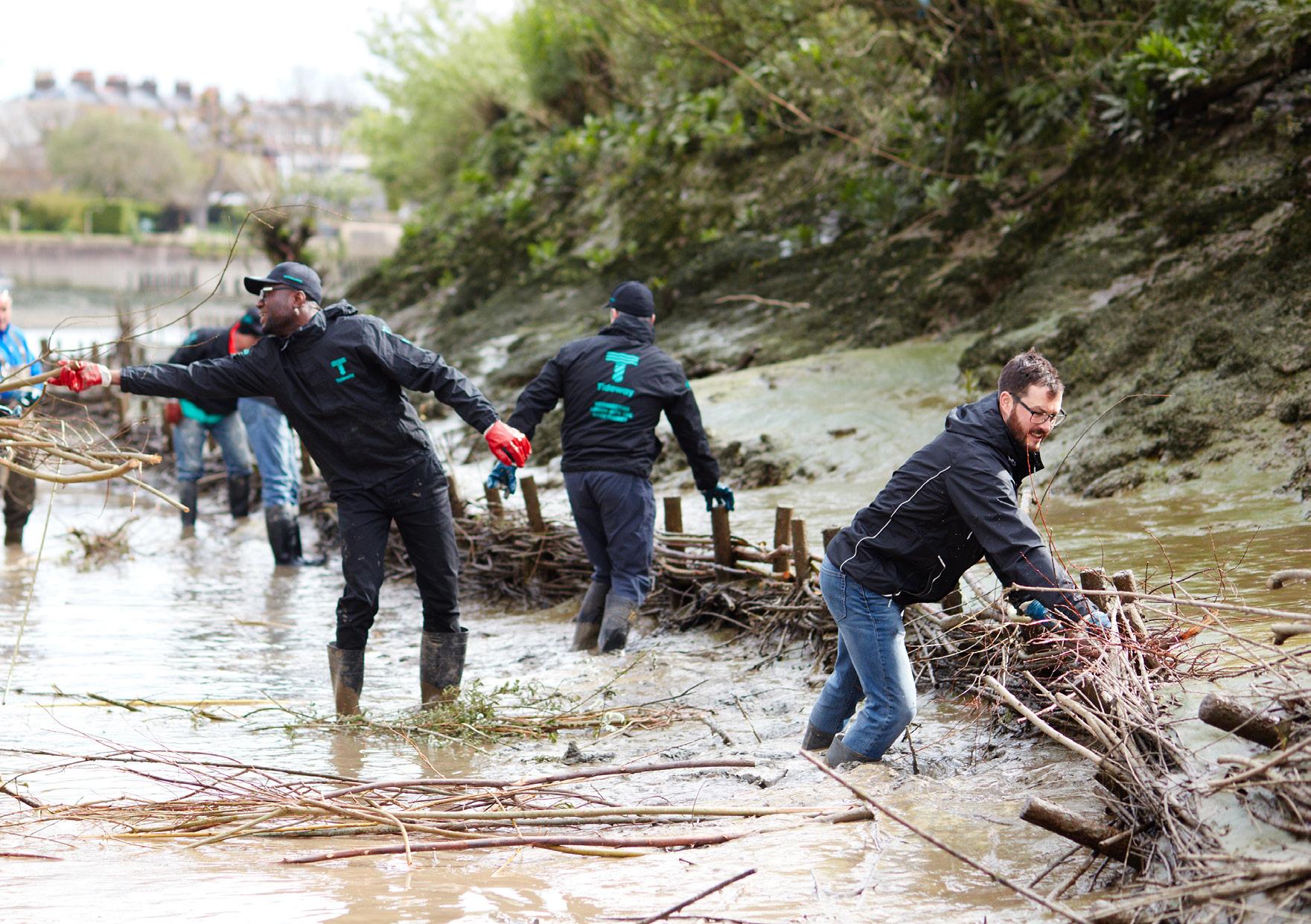
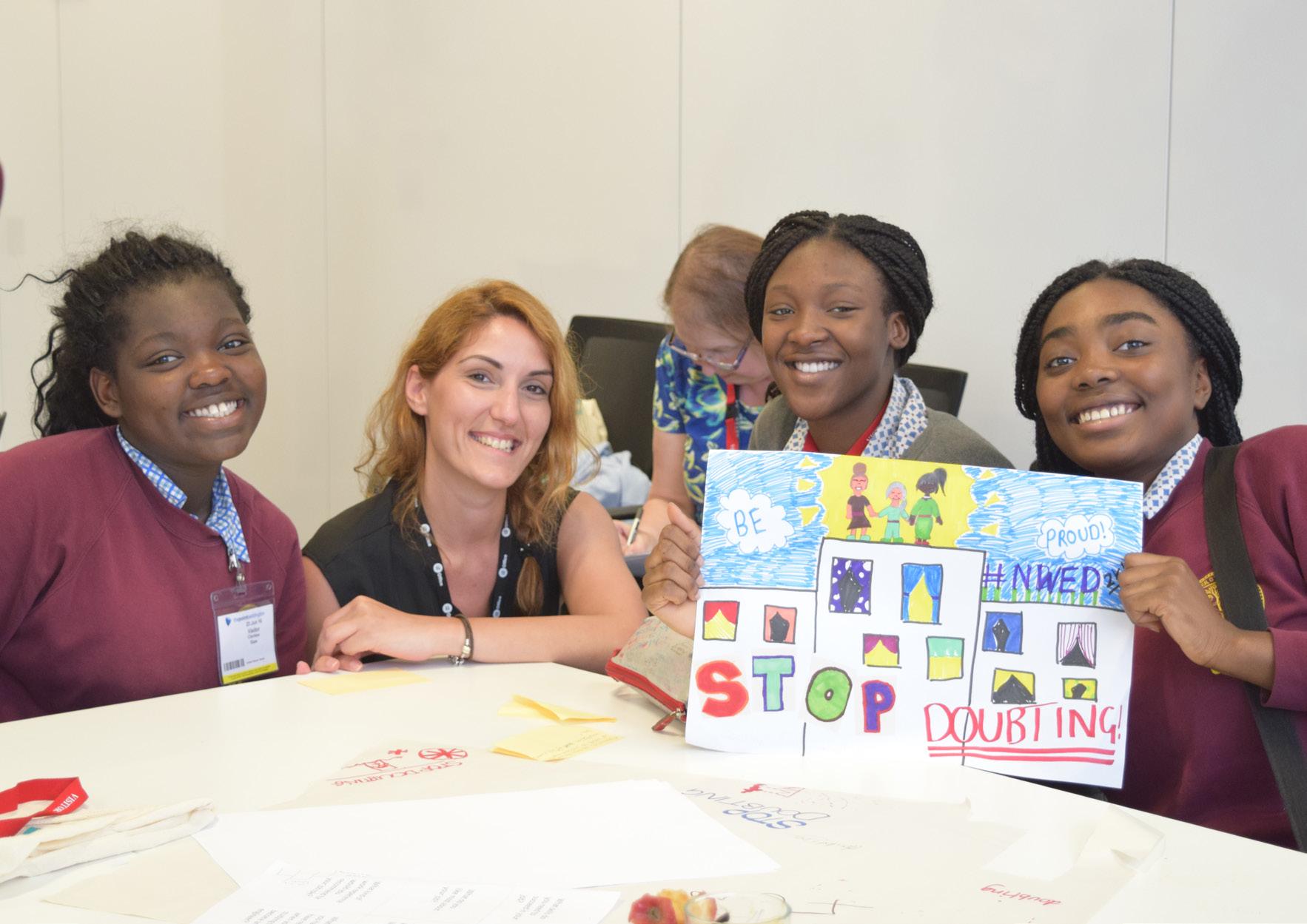

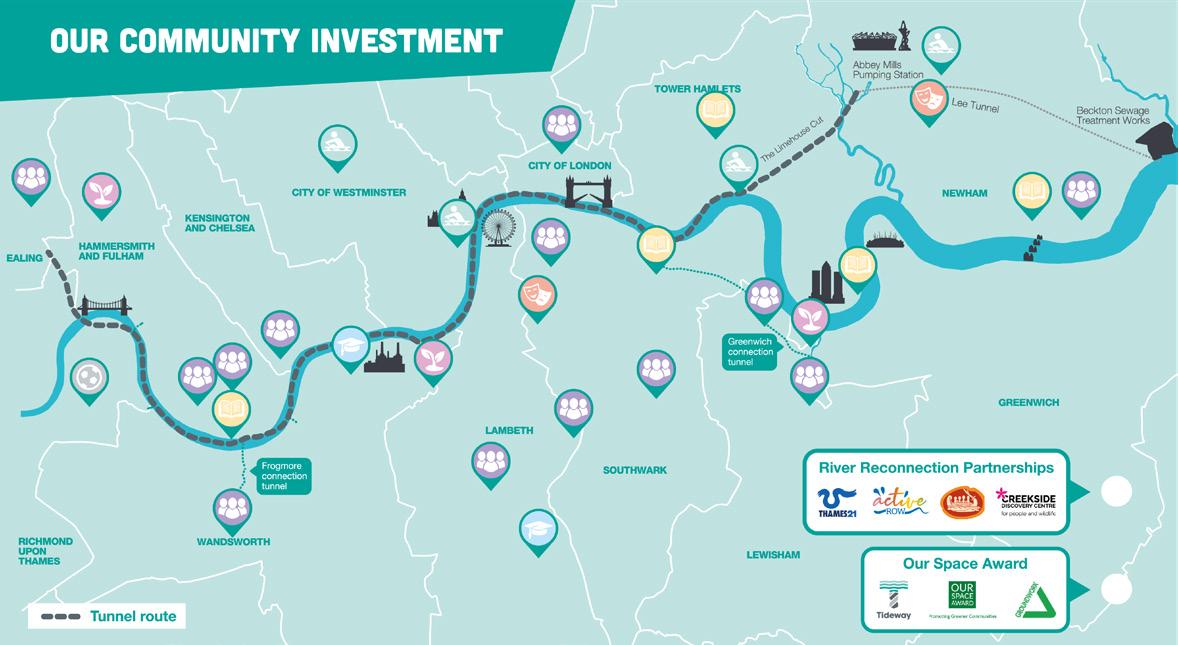

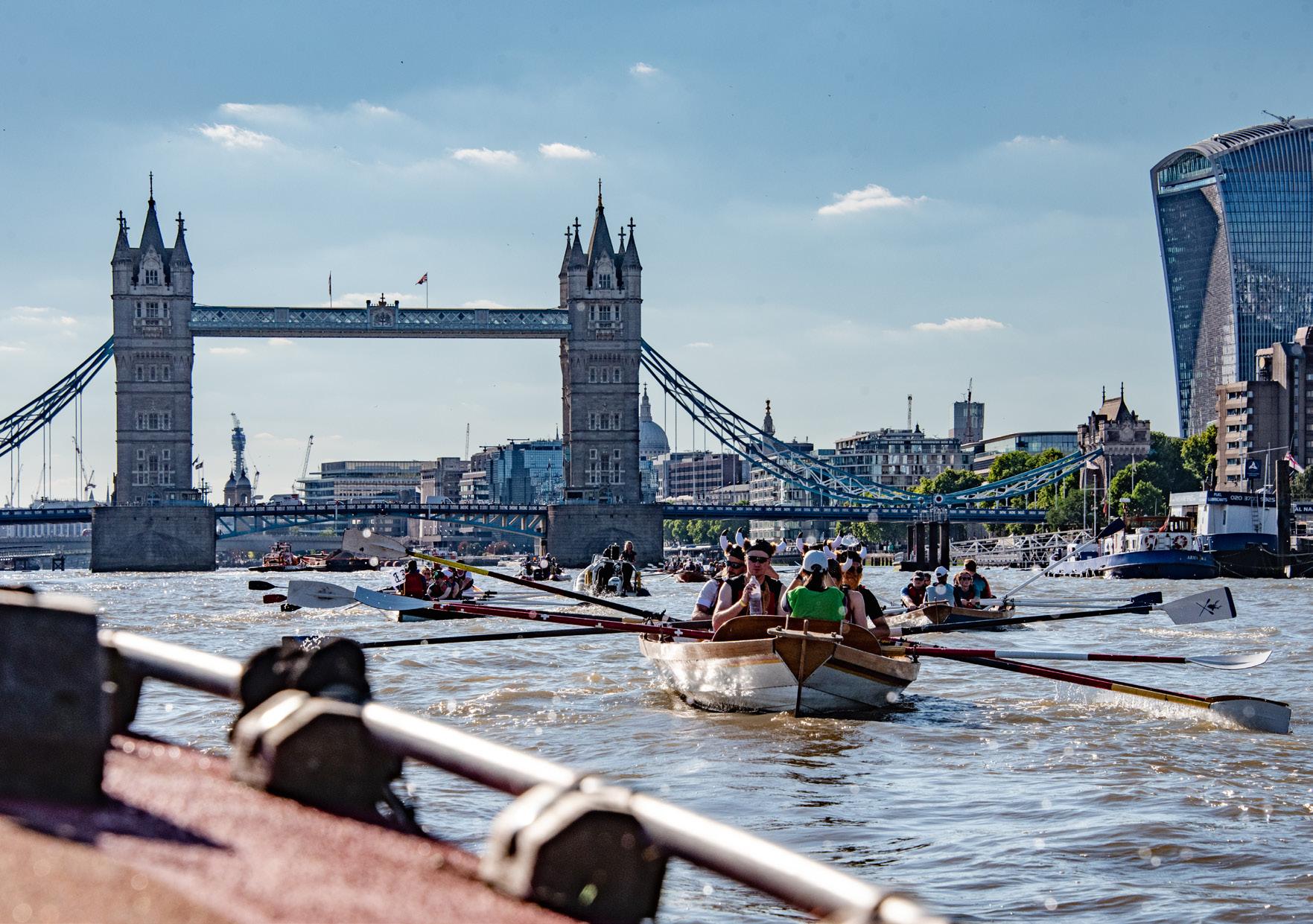
A transformational approach. Doing things the ‘RightWay’.
That’s the philosophy behind our aim to leave a legacy for health, safety and wellbeing on major projects. Across the Tideway project, we called it the RightWay.
This ambition has meant thinking differently - from safety culture to personal protection equipment; from site layout to supporting wellbeing.
A prime example of different thinking was around project inductions. We introduced EPIC – which stands for Employer’s Project Induction Centre –as a new way of creating the right culture from day one. EPIC is a one-day, immersive experience attended by everyone working on the project, from tunnel operatives to delivery drivers and office staff. The key message of EPIC is that we do things ‘safely or not at all’.
Staff are immersed in an on-site storyline, supported by a cast of actors, working in specially designed sets. There is also a separate EPIC Logistics induction which is a Fleet Operator Recognition Scheme (FORS) accredited course for HGV drivers. More than 26,000 people have attended EPIC and the model has now been embraced by several other projects in the UK.
“An excellent example of Tideway’s transformational approach to occupational health and safety” Loughborough University researchers on the EPIC induction
EPIC has successfully driven behaviours and culture. The most immediate legacy is a strong record – the project has a lower incident and injury rate compared to published data for the sector – that has clear benefits for society: our social impact report valued it at £18.75 million.
We’ve not just focused on site. Even with our ‘more by river’ approach, there were risks for vulnerable road users from lorry deliveries, and we introduced industry-leading initiatives to reduce these, including a fleet of
27 ‘Low Entry Cab’ (LEC) vehicles that increase the amount of direct driver vision. Our innovations continued as the tunnel came into operation. We introduced drones for routine inspections, removing the need for people to go underground. Safer, by design.
You can read several sources for more about Tideway’s industry legacy in health, safety and wellbeing - research from the Institution of Occupational Health and Safety, an Institution of Civil Engineers paper and Tideway’s final Sustainability Report.
Another key industry legacy is the success of Tideway’s sustainable financing model.
Since the project began, the question of how the UK funds improved water infrastructure to protect our rivers has climbed to the top of the public agenda. Tideway is already providing a model for successful project financing that other projects are following.
The model, called Regulated Asset Base, encourages long-term, low-cost private sector investment in infrastructure projects. It has key features that have reduced risk for all parties – consumer protection via regulation; a government guarantee as “insurer of last resort”; and investor returns during construction as costs are recovered through customer bills. The cost for consumers remains within (or lower than) the original estimate of £20-25 per year, at 2014-15 prices.
Tideway has created sustainable financing firsts within this model which also leave a legacy. In 2017 we became the largest corporate issuer of Green Bonds - used to fund projects that deliver positive environmental benefits – in Sterling. We followed this by linking the cost of debt to successful legacy programme delivery – a first for UK infrastructure. And in 2025 we became the first UK company to issue a Blue Bond in SterlingBlue Bonds are designated to denote specific investor benefits to seas and marine environments.
The London Stock Exchange said: “Congratulations to Tideway…this new Blue Bond underscores the company’s core mission. A strong step forward for sustainable finance.”
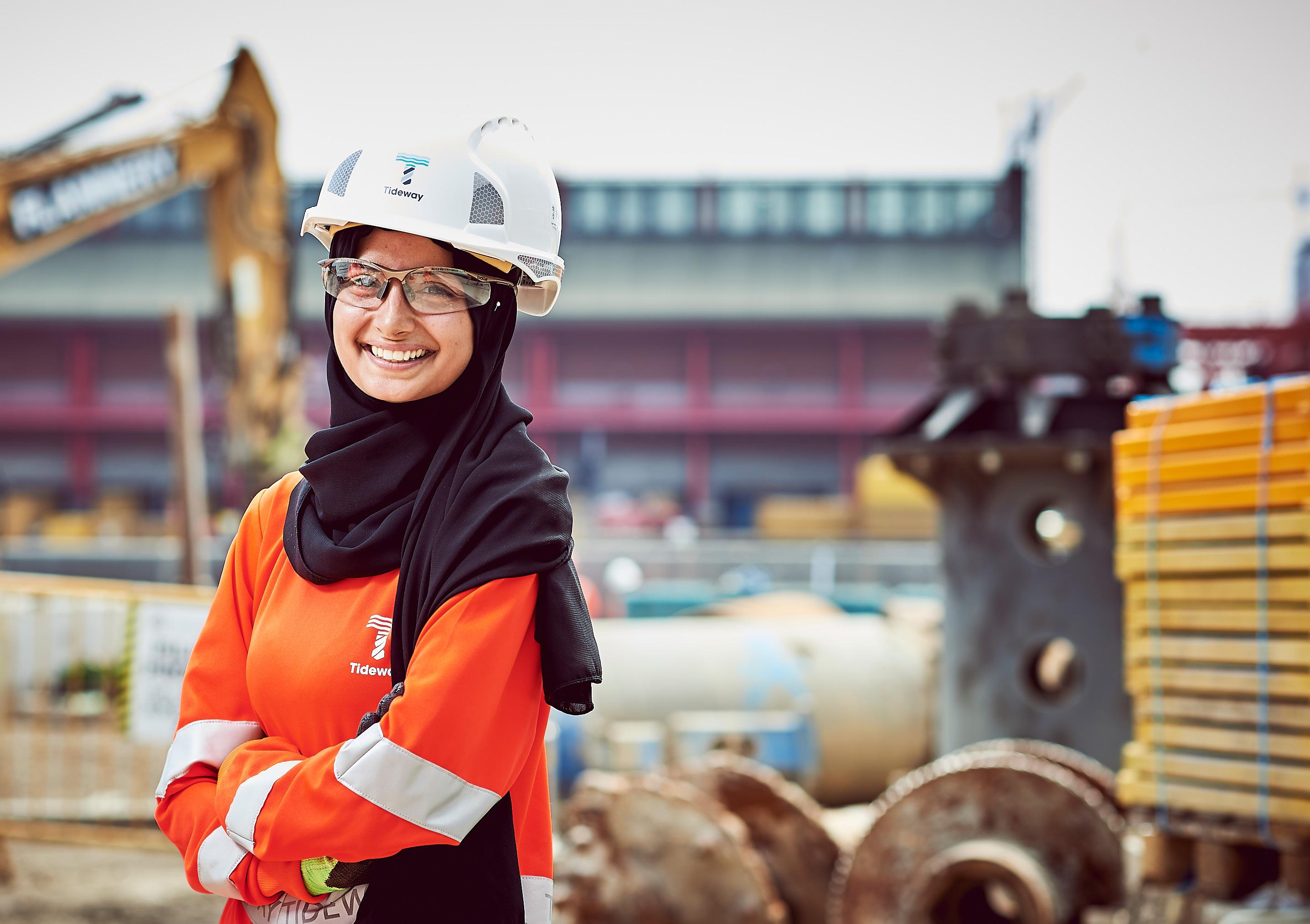
As an extension of RightWay, we wanted to foster an inclusive culture and tackle inequality in construction.
We established an Encompass forum – for staff across the project –to promote an understanding of each other as individuals; recognise difference; and provide practical support, education and training.
We encouraged innovation and input from staff. One of the ideas that came through our Innovation programme was from Health, Safety and Wellbeing Coordinator Leena Begum (pictured), who put forward a PPE design for women who respect the hijab and burka, which was a first for construction – Leena had encountered difficulties in finding suitable protective clothing to wear on site. With the support of colleagues, she was encouraged to present her original designs to the manufacturers and these subsequently went into production. Tideway was also the first construction project to provide maternity PPE.
A detailed study on Encompass for our social impact report carried out workshops and a company-wide survey which concluded ‘Encompass is making a difference’. The vast majority of Tideway staff (91 per cent) said they have seen managers setting a good example and 85 per cent feel respected by their colleagues – both scores are consistently higher than industry benchmarks.
Tideway has been recognised with major awards for our project’s work to deliver major environmental and social benefits to London. Here are just some of them:




